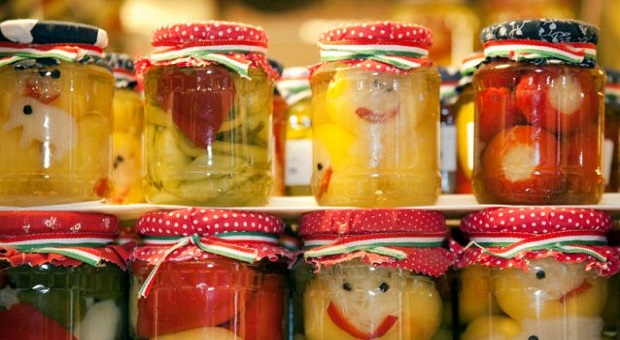While it’s true that you can get just about anything to grow anywhere in the right conditions, those conditions sometimes have to be contrived to the point that it’s impossible for the average person to pull off.
Fortunately, these types of crops are rare. My goal for this article is to make a list of top foods to preserve by region.
Know that with just a few exceptions, you can probably grow pretty much whatever you want as long as you make allowances for growth periods and temperatures.
Some things though, you’ll have to just have to break down and buy if you don’t live in say, a tropical area.
For instance, I live in Florida, so I can grow an orange, lemon, lime, grapefruit or banana tree right in my backyard. Same thing with pineapples and sugarcane. Tomatoes, cucumbers, and watermelon grow well here, too because of the soil and the practically year-round growing season.
That’s not the case in most of the rest of the country, with the exception of California (and even they don’t have sugarcane).
On the other hand, if I want a really good apple or peach, I have to pay $2.99/pound for them because Florida is just too hot, too sandy, and pretty much too everything that an apple or peach tree won’t grow in.
Each region has foods that grow particularly well, as well as unique needs that may need to be met in order to allow for long enough growth cycles. That’s what we’re going to talk about today.
Food to Grow by State
First, I’ll share a list that I found from the USDA Economic Research Service. These list the top grown commercial agricultural products, including meat and grains, so that you get an idea of what conditions you may need if you want to grow a particular crop. They only list a few per state, but it’s a start.
I also went through and added other crops that I found in my research, since this was just a sample of exports, not foods that grow particularly well in the state.
Alabama: poultry, cattle, eggs, peanuts
Alaska: greenhouse plants, hay, potatoes
Arizona: dairy, cattle, greenhouse plants, lettuce, barley
Arkansas: poultry, rice, soybeans
California: dairy, greenhouse plants, grapes, citrus, tomatoes
Colorado: cattle, dairy, corn, potatoes
Connecticut: greenhouse plants, dairy, eggs, apples, berries
Delaware: poultry, corn, soybeans, watermelon
Florida: greenhouse plants, oranges, tomatoes
Georgia: poultry, eggs, cotton, peaches, peanuts, blueberries
Hawaii: greenhouse plants, sugarcane, macadamia nuts, pineapples
Idaho: dairy, cattle, potatoes
Illinois: corn, soybeans, hogs, pumpkins
Indiana: corn, soybeans, hogs, tomatoes
Iowa: corn, soybeans, hogs, green peas
Kansas: cattle, wheat, corn, sandhill plums
Kentucky: horses, poultry, corn, watermelon
Louisiana: rice, corn, sugarcane, peppers, tomatoes
Maine: potatoes, dairy, eggs, blueberries
Maryland: poultry, greenhouse plants, corn, watermelon
Massachusetts: greenhouse plants, cranberries, diary
Michigan: dairy, corn, soybeans, cherries
Minnesota: corn, soybeans, hogs, Honeycrisp apples, potatoes, peas
Mississippi: poultry, soybeans, corn, sweet potatoes
Missouri: soybeans, corn, cattle, watermelon
Montana: wheat, cattle, barley, dry peas
Nebraska: cattle, corn, soybeans, dry beans
Nevada: cattle, hay, dairy, potatoes
New Hampshire: greenhouse plants, dairy, apples
New Jersey: greenhouse plants, horses/mules, blueberries, apples
New Mexico: dairy, cattle, hay, chili peppers, pecans
New York: dairy, greenhouse plants, corn, apples
North Carolina: poultry, hogs, greenhouse plants, sweet potatoes
North Dakota: wheat, soybeans, corn, dry beans
Ohio: corn, soybeans, dairy, apples
Oklahoma: cattle, wheat, hogs, peanuts
Oregon: greenhouse plants, cattle, dairy, pears
Pennsylvania: dairy, cattle, eggs, apples, mushrooms
Rhode Island: greenhouse plants, dairy, corn, apples
South Carolina: poultry, greenhouse plants, turkeys, peaches
South Dakota: corn, cattle, soybeans, oats
Tennessee: cattle, poultry, soybeans, snap peas
Texas: cattle, cotton, dairy, rice
Utah: dairy, cattle, hay, cherries, peaches, apples, apricots
Vermont: dairy, cattle, greenhouse plants, maple syrup
Virginia: poultry, cattle, dairy, tomatoes
Washington: apples, dairy, wheat
West Virginia: poultry, cattle, turkeys, apples, maple syrup, ramps, mushrooms
Wisconsin: dairy, corn, cattle, cranberries
Wyoming: cattle, hay, hogs, dry beans
Now, it may be good to find out what conditions certain common crops like, so that you can either choose ones that are best for your area, or make some tweaks in soil, or indoor starts in order to grow what you want.
If you live in a cold area, a greenhouse is always a great option to expand your growing options, and there are some great options for underground greenhouses that are absolutely amazing. I fully intend to have one if I ever move back north.
Growing Basic Food You Need in Your Stockpile
Apples
Apples need a temperate climate with a cold snap in the spring to get nice blooms, but if it frosts after the tree blooms, it likely won’t fruit.
The Honeycrisp apple is an exception; it was developed by the University of Minnesota specifically for growing in cold climates.
Lettuce
Lettuce loves hot climates with lots of sun but you can grow it pretty much anywhere as long as it hits seventy degrees or so.
Leaf lettuce grows quickly – within a few weeks – so you can have fresh lettuce all spring, summer, and fall as long as it doesn’t frost. And you can grow it indoors too, in a window.
Tomatoes and Peppers
They enjoy similar growing conditions. They like the soil a combination of loamy and sandy and it needs to drain well, but hold a little water.
They also need full sun unless you live in a crazy hot place like I do, then they only need about a half-day of sun. They need 3-4 months of warm weather to produce their best.
Potatoes
They are one of the easiest crops to grow, and you can store them as-is for a few months if you have a cool, dry place such as a cellar to do it in. They’re a cool-weather crop and grow best in the northern states, though you can grow them anywhere you want.
They need fertile, well-drained soil that’s loose and slightly acidic (pH 5.8-6.5). If the soil is hard, the potatoes will look deformed. Some people actually grow them in straw instead of planting them!
Beans
Beans are a warm-weather crop, and it’s good to start a few new plants every ten days or so in the spring to ensure beans all summer. Direct sow them into the garden 1-2 weeks after the last frost when the soil is at least 60 degrees.
Start them indoors 2-3 weeks before transplanting. Bush beans are ready in 45-60 (frost-free) days and pole beans mature in 60-85 (frost-free) days. Optimal soil temp is 70-80 degrees F and the like he soil to be just a touch acidic.
Fava Beans
These are the exceptional bean that likes cool weather; as a matter of fact, they don’t grow well in temps over 80 degrees, and their ideal temp is 60-65 degrees. They can withstand a low of 40 and a high of 75, so don’t plant them in the summer if you live in a hot area that exceeds these temperatures.
In areas that experience all 4 seasons, start them in the early spring just as the soil’s starting to thaw. What may be best about them is that they are fabulous for the soil, as ground plants, or “green” manure.
Cucumbers and Squash
They are warm weather plants. Some sites even call them tropical because they like the heat so well, especially cucumbers. The have a short growing season and need full sun.
Unlike tomatoes, they can take the sun all day and grow best in 70-90 degree soil and even a light frost will kill them. They like the soil a little acidic – 6-6.8 pH and can go as far alkaline as 7.6. Anything more alkaline than that isn’t good. They like the soil moist but not wet.
I grew cukes and squash both in WV, which has a moderate climate, and we always had great crops. We covered the garden in black plastic to help warm the soil sooner, and always had wonderful … well … everything.
Corn
Corn is another crop that will grow just about anywhere in the United States. It does need a longer frost-free growing season, but again, we grew it just fine in WV, where the last frost is in April-ish and the first can be as early as October.
Soil temps need to be at least 60 degrees when you plant them, and it needs to stay above 60 for the duration.
Since it has shallow roots, make sure that it has plenty of water when the weather is warm. It’s a heavy feeder and needs nutrient-rich soil, especially nitrogen, so use good compost and, if you practice partner planting, plant it with beans.
Beets
Beets are a great cool-weather crop. They don’t do well in heat at all, which sucks for me now because I love them – especially pickled. And they’re crazy good for you – they’re considered a “superfood” because of all of the antioxidants in them.
However, They like it cold. They also need deep, well-drained, loose soil so that the beet can grow properly, since it’s a root veggie like a carrot.
Plant them in early spring and late fall. They only need about 65 days to mature, and you can plant them as soon as the soil hits 40 degrees.
Now that you have a general idea of what conditions most of the major crops need, you can plan your garden and make the tweaks to your soil that you may need in order to grow most everything that you want.
Did I miss anything, or do you have any other good tips to share? If so, please do so in the comments section below.







































































With respect to Arizona, I’m surprised that you didn’t include corn. We grow quite a lot of it commercially at elevations below 3,000 feet, as well as strawberries and other table vegetables. Otherwise, your list is good.
Loved the article. Idaho also grows lots of corn onions and stone fruits commercially. Can you direct us to the source of the companion planting chart? I cannot print it out clearly, even after downloading the PDF. I would like to put a copy with my seed supply and in my gardening area. Thanks.